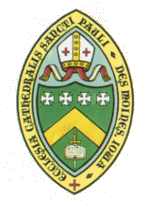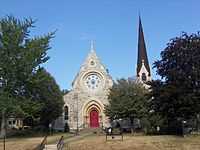Cathedral Church of Saint Paul (Des Moines, Iowa)
|
St. Paul's Episcopal Church | |
 | |
 | |
| Location |
815 High Street Des Moines, Iowa |
|---|---|
| Coordinates | 41°35′16.95″N 93°37′44.4″W / 41.5880417°N 93.629000°WCoordinates: 41°35′16.95″N 93°37′44.4″W / 41.5880417°N 93.629000°W |
| Built | 1885 |
| Architect | Foster & Liebbe |
| Architectural style | Gothic Revival |
| Governing body | Private |
| NRHP Reference # | 10000129 [1] |
| Added to NRHP | March 31, 2010 |
The Cathedral Church of St. Paul, is located in downtown Des Moines, Iowa, United States. It is the cathedral church of the Episcopal Diocese of Iowa. The building was listed on the National Register of Historic Places in 2010 as St. Paul's Episcopal Church.
History
St. Paul's Episcopal Church

St. Paul's had its beginnings on October 15, 1854 when the first service was held at Fort Des Moines for ten communicants.[2] A brick and frame church building was completed in 1857 on Seventh Street between Locust and Walnut Streets. By 1870 the congregation decided to replace its church building and purchased the current site.
The present church building was completed in 1885. It was designed by the Des Moines architectural firm of Foster & Liebbe in the Gothic Revival style. Its basement was not exposed as it is now because Ninth and High Streets were lowered at a later date. Originally the church had a wooden steeple, but it was destroyed in a storm in the 1930s. It was replaced in the 1960s by a structure with a steel core. Later the tower was strengthened when the 25-bell carillon was added. A kitchen was added below the sanctuary in 1939. The Rambush Company redecorated the chancel in the 1940s and the current reredos was added at that time.
In 1950 the parish's rector, the Rev. Gordon V. Smith, was elected the sixth Bishop of Iowa. The parish house was built in 1952. The building was designed by Proudfoot, Bird and Rawson, and Brooks Borg Architects of Des Moines. The new addition created space for classrooms, clergy and staff offices, the Guild Hall, and a chapel.
The Rev. S. Suzanne Peterson was ordained a deacon at St. Paul's on December 18, 1976. She was the first woman ordained in the Diocese of Iowa.[3]
A $1.4 million[4] renovation was undertaken in the 1980s when the congregation decided to remain downtown. William Dikis was the architect for the project. Further renovations were undertaken to the chancel area when St. Paul's was made the cathedral of the diocese. The cathedra (Bishop's chair), hand carved by a local artist, was installed in 1993, as was the current pipe organ. The new organ, Opus 3719,[5] was built by Casavant Frères, Ltd of Saint-Hyacinthe, Quebec. The St. Sacrament Chapel was added at this time, reusing the original tabernacle, and providing accessibility for communicants with mobility challenges .
Over the years St. Paul’s has assisted in the establishment of new mission churches in the Des Moines area. These churches and the year they were established include: St. Luke's in 1905, St. Andrew's in 1950 and St. Timothy's in 1960.
Cathedral Church
In 1992 the Diocese of Iowa decided that St. Paul's would become the liturgical cathedral for the Diocese of Iowa. It shares this distinction with the diocese’s historic cathedral in Davenport, Trinity Cathedral. The liturgical ceremony designating St. Paul's as the cathedral took place on October 23, 1993. Bishop C. Christopher Epting, who had been the diocesan bishop since 1988 took his seat in the new cathedral in December 1993. Present at the ceremony was the founding Dean, the Very Rev. Michael Barlowe (later Executive Officer of the General Convention of the Episcopal Church), and Bishop Lawrence Edward Luscombe, the retired Bishop of Brechin and former Primus of the Scottish Episcopal Church.[6]
Pipe organ
The Casavant Frères Ltée., (Opus 3719, 1997) pipe organ is located in the front of the sanctuary with some of the pipes exposed. It features a traditional style console with roll top.[7] It is equipped with three manuals, seven divisions, 84 stops, 51 registers, 68 ranks, 3904 pipes, and electro-pneumatic (EP) chests. The manual compass is 61 notes and the pedal compass is 32 notes. The drawknobs are arraigned in vertical rows on angled jambs. There are balanced swell shoes/pedals with a standard AGO placement. The combination action is a computerized/digital system. Rounding out the features are AGO Standard (concave radiating) pedalboard, reversible full organ/tutti thumb piston, reversible full organ/tutti toe stud, combination action thumb pistons, combination action toe studs, coupler reversible thumb pistons, and coupler reversible toe studs.
Stoplist:[7]
GRAND ORGUE
|
RÉCIT
|
CHAMADE (floating)
ANTIPHONAL (floating)
|
CHOEUR
|
PÉDALE
ANTIPHONAL PEDAL
a=1-12 from Flûte à cheminée b=added in 2009; located at the rear of the nave |
References
- ↑ "National Register Information System". National Register of Historic Places. National Park Service. 2010-07-09.
- ↑ "History". Cathedral Church of Saint Paul. Retrieved 2010-03-30.
- ↑ Horton, Loren N. (2003). The Beautiful Heritage: A History of the Diocese of Iowa. Des Moines: Diocese of Iowa. p. 108.
- ↑ "Architecture". Cathedral Church of Saint Paul. Retrieved 2010-03-30.
- ↑ "Organ". Cathedral Church of Saint Paul. Retrieved 2010-03-30.
- ↑ Horton, 121
- ↑ 7.0 7.1 "Casavant Frères Ltée., Opus 3719, 1997". OHS Pipe Organ Database. Retrieved 2013-08-19.
External links
| ||||||||||||||||||||||||||
